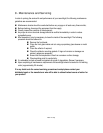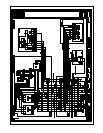Failure of Lamp to Ignite
In the event of the xenon lamp failing to light the following steps should be taken:
1) Check that the mains supply is connected to the input of the PSU. On operating the switch, if
the lamp does not light, switch off mains supply and check all fuses;
2) On pressing remote starting switch the lamp still does not ignite, check the searchlight head.
On your command get an operator to activate the starting switch for approximately 10 seconds.
During this time listen for any noise (cracking or hissing) coming from within the barrel. If this
arcing is heard switch off the supply at the mains. Remove the rear bezel to expose the two
supply leads to the xenon lamp. Using a dry cloth wipe these leads to remove any dust,
moisture or condensation that may have formed around the inside of the barrel. Replace the
rear bezel, ensuring the latches are securely fastened, and perform the check again, listening
for the cracking. If the lamp still fails to ignite, switch off at the mains and replace the xenon
lamp in accordance with the safety procedures within this manual and the manufacturers
information.
Any further tests to be carried out with regards to lamp failure must be conducted by a
competent electrical engineer and should not be carried out in an explosive atmosphere.
3) Before a xenon lamp will ignite, the electrically insulated gas between the electrodes must be
ionised. This is done by the ignitor which produces a high frequency voltage (up to 30,000 volts
or higher). The ignitor is activated by switching the lamp on and a crackling or hissing noise
should be heard. The ignitor is housed within the rear of the searchlight barrel. This is a totally
encapsulated unit and repair is not advised. If found to be faulty a new ignitor must be fitted.
Failure of Remote Focus Facility
The remote focus mechanism is controlled by a small electric motor situated at the rear of the
searchlight barrel. If the focus of the light fails the following procedure should be adopted:
1) Remove the rear bezel from searchlight barrel and examine focus mechanism. If parts have
become loose, tighten fasteners. The mechanism operates on a lever action and this should be
checked for correct positioning;
2) If the mechanism is okay, check the supply to the motor. This can be done by simply placing a
multi-meter across the motor terminals;
3) If supply is present, this indicates that the motor has failed. Replace the focus motor ensuring
that the assembly is correct;
4) If no supply is present there is a fault in the junction box. This should be examined and rectified
accordingly.
Note: If a fault occurs on the motor gearbox, the unit should be returned to Francis
Searchlights Limited for fault evaluation and repair.
Back To Top


















